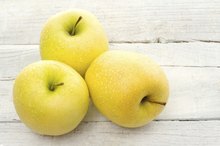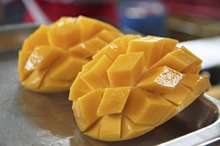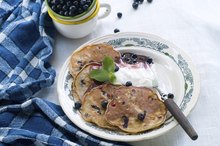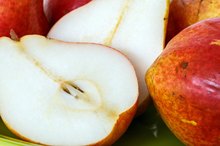What does fact checked mean?
At Healthfully, we strive to deliver objective content that is accurate and up-to-date. Our team periodically reviews articles in order to ensure content quality. The sources cited below consist of evidence from peer-reviewed journals, prominent medical organizations, academic associations, and government data.
The information contained on this site is for informational purposes only, and should not be used as a substitute for the advice of a professional health care provider. Please check with the appropriate physician regarding health questions and concerns. Although we strive to deliver accurate and up-to-date information, no guarantee to that effect is made.
How Many Calories Does a Pear Have?
More than 3,000 known varieties of pears exist, though only about 10 of these are commonly available in grocery stores. Pears are wonderfully sweet fall fruits that pack a nutritional punch in a small 100-calorie package. Each variety has subtle differences in flavor and nutritional profile, yet all can be a nutritious addition to your diet.
Calorie Content of Pears
According to the USDA National Nutrient Database of foods, one medium-size fresh pear provides 100 calories, 5.5 grams of fiber, 27 grams of carbohydrate and more than 200 milligrams of potassium 234. Bartlett pears contain 112 calories, 7 grams of fiber and 26 grams of carbohydrate, compared to Asian pears, which contain 116 calories, 10 grams of fiber and 29 grams of carbohydrates. All pears are a good source of vitamin C, meaning they provide more than 10 percent of the recommended daily value. Pears are naturally fat free, saturated fat free, cholesterol free and sodium free.
- According to the USDA National Nutrient Database of foods, one medium-size fresh pear provides 100 calories, 5.5 grams of fiber, 27 grams of carbohydrate and more than 200 milligrams of potassium 2.
- All pears are a good source of vitamin C, meaning they provide more than 10 percent of the recommended daily value.
Part of a Healthy Diet
List of Roughage Foods
Learn More
Diets rich in fruits and vegetables provide an abundance of antioxidants for cell protection and disease prevention. The 2010 Dietary Guidelines for Americans recommends filling half of your plate with fruits and vegetables to boost nutrients without adding too many calories 7. The high-fiber content of pears makes them a good choice for those watching their weight, because this fruit can help you feel fuller without taking in excessive calories. Try having a pear before your meal to curb your appetite for other higher-calorie foods.
- Diets rich in fruits and vegetables provide an abundance of antioxidants for cell protection and disease prevention.
- Try having a pear before your meal to curb your appetite for other higher-calorie foods.
Related Articles
References
- USA Pears: Nutrition Facts
- USDA National Nutrient Database: Pear
- USDA National Nutrient Database: Bartlett Pear
- USDA National Nutrient Database: Asian Pear
- Fruits and Veggies More Matters: Pears
- Harvard School of Public Health: Antioxidants
- USDA: 2010 Dietary Guidelines for Americans
- Reiland H, Slavin J. Systematic review of pears and health. Nutr Today. 2015;50(6):301-305. doi:10.1097/NT.0000000000000112
- Pears, raw. FoodData Central. U.S. Department of Agriculture. Published April 1, 2019.
- Soliman GA. Dietary fiber, atherosclerosis, and cardiovascular disease. Nutrients. 2019;11(5):1155. doi:10.3390/nu11051155
- Atkinson FS, Foster-Powell K, Brand-Miller JC. International Tables of Glycemic Index and Glycemic Load Values: 2008. Diabetes Care. 2008;31(12):2281-2283. doi:10.2337/dc08-1239.
- Dietary Reference Intakes (DRIs): Recommended Dietary Allowances and Adequate Intakes, Elements. National Institutes of Health, Food and Nutrition Board. Updated 2011.
- Desai V, Kaler SG. Role of copper in human neurological disorders. Am J Clin Nutr. 2008;88(3):855S-8S. doi:10.1093/ajcn/88.3.855S
- Stone MS, Martyn L, Weaver CM. Potassium intake, bioavailability, hypertension, and glucose control. Nutrients. 2016;8(7):444. doi:10.3390/nu8070444
- Carr AC, Maggini S. Vitamin C and immune function. Nutrients. 2017;9(11):1211. doi:10.3390/nu9111211
- Wedick NM, Pan A, Cassidy A et al. Dietary flavonoid intakes and risk of type 2 diabetes in US men and women. Am J Clin Nutr. 2012;95(4):925-33. doi:10.3945/ajcn.111.028894
- Larsson SC, Virtamo J, Wolk A. Total and specific fruit and vegetable consumption and risk of stroke: A prospective study. Atherosclerosis. 2013;227(1):147-52. doi:10.1016/j.atherosclerosis.2012.12.022
- Hu D, Huang J, Wang Y, Zhang D, Qu Y. Fruits and vegetables consumption and risk of stroke: A meta-analysis of prospective cohort studies. Stroke. 2014;45(6):1613-9. doi:10.1161/strokeaha.114.004836
- Anderson JW, Baird P, Davis RH, et al. Health benefits of dietary fiber. Nutr Rev. 2009;67(4):188-205. doi:10.1111/j.1753-4887.2009.00189.x
- Lee HS, Isse T, Kawamoto T, Baik HW, Park JY, Yang M. Effect of Korean pear (Pyruspyrifolia cv. Shingo) juice on hangover severity following alcohol consumption. Food Chem Toxicol. 2013;58:101-6. doi:10.1016/j.fct.2013.04.007
- Oral Allergy Syndrome (OAS) or Pollen Fruit Syndrome (PFS). American Academy of Allergy Asthma & Immunology.
- Dirty Dozen: EWG's 2019 Shopper's Guide to Pesticides in Produce. Environmental Working Group. Updated 2019.
- Pears, asian, raw. FoodData Central. U.S. Department of Agriculture. Published April 1, 2019.
Writer Bio
Based in Colorado, Stephanie M. Beaudette has been a registered dietitian/nutritionist for over 18 years providing nutrition education and training to healthcare providers and the public. She received her Master of Education in nutrition sciences from the University of Cincinnati. Beaudette has extensive experience in prenatal nutrition, women's health, weight management and promoting overall health and wellness.









